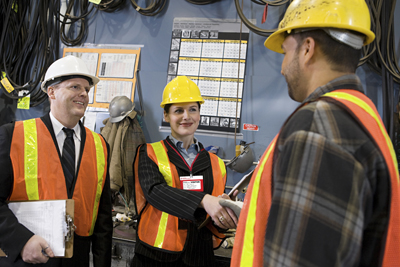Blog
Understanding the importance of Crisis Management Teams
by Paul Kazlauskas

Our society has witnessed (too many times to count) that incidents of human-created terror or natural disasters can happen anywhere in the world. Schools, healthcare facilities, and businesses of all kinds are vulnerable. There is no longer a mythical place of “it can’t happen here.” For that reason, building security officials need to be well-versed in crisis management.
In a past blog post, I covered tips for what to do before, during, and after a security crisis in the workplace. However, I want to add a security concept to the list of “before” activities that has gained popularity over the last half-decade: creating a Crisis Management Team.
The role of the Crisis Management Team (CMT) is to manage events and ensure appropriate actions are carried out. Potential risks and impacts are considered before they happen. The CMT primarily focuses on detecting the early signs of a crisis and identifying vulnerable areas. They prepare a crisis management plan for a number of emergency situations. The Crisis Management Team’s planning ahead of time and action during an emergency will help an organization through a tough time.

Multiple crisis teams may exist, with each activating and providing guidance depending on the situation. For example, IT may have a crisis team that activates related to actual or potential IT-related outages, with no other members of the overall Crisis Management Team triggered to act in that scenario.
People on the CMT need to have a high-level view of the business as a whole, as well as a specialty of knowledge in their department. They need to be advocates for their department and be leaders of action for their area. Each CMT member should be well-versed in the department’s risk potential.
With the above in mind, here are some tips for creating a quality Crisis Management Team. For smaller organizations, multiple roles may be shared by a single person.
Accept the role of a teacher
Learn about the issues your organization faces. Educate yourself on the potential risks within your department and other departments close to you. You may not have the authority to choose who will be on the team, but an educated professional will have the opportunity to share what they know with upper management and steer the organization in a positive direction.
Make sure the CMT is properly represented
The Crisis Management Team should comprise members from the following areas:
- Communications
- Legal
- Risk Management
- IT
- Finance
- HR
- Warehouse (if it exists)
- Impact/Damage Assessment (if it exists)
It is important to have representation from all areas of the company. As mentioned, smaller organizations may not have a single person per department and may require a person to wear multiple “expertise hats.” You may need to pull in members of other departments depending on the situation.
Create an understanding of what kinds of people work best on a CMT (including picking an appropriate leader)
Crisis situations are stressful and chaotic. Many distractions and situations arise that test a person’s mental toughness. Not every person has the skill sets for working competently and efficiently in these situations. Characteristics of a good CMT member include:
- Ability to make a timely decision based on information at hand
- Self-confidence
- Good at problem solving
- Are willing to act in the absence of a consensus
- Calm in high-pressure situations
- Thick-skinned when it comes to criticism
- Possess a can-do attitude and can collaborate well with others
It is important to truly evaluate a potential CMT member based on the characteristics above. It is a false assumption that a high-ranking director or manager should automatically be on the CMT just because of their position in the company. If they truly don’t possess the characteristics mentioned in the above bullets, they shouldn’t be on the team. Sometimes, the politics of an organization will trump the advice above. If a senior official insists on being part of the team despite not possessing the needed characteristics, a person under them with the correct characteristics should be included on the team as well.
Once formed, the Crisis Management Team can begin evaluating potential vulnerabilities of the organization. Communication with all employees is critical to understanding potential issues. The CMT will prioritize the issues facing the facility. The problems will be ranked by their effect on the employees, as well as on the organization. The CMT will identify which problems must be resolved immediately and which can be attended to at a later date. Once policies are set and training has been conducted, the CMT will follow up at later times with spot checks and drills because following up on procedures is as important as the procedures themselves.
It is regrettably more likely than not that your organization will find itself dealing with a crisis at some point. Whether it be a data breach, natural disaster, workplace violence, or some other catastrophe, your organization needs to know how to react in a timely and efficient manner to the situation unfolding. Having a quality team in place and thinking through various situations proactively will help your organization deal with the issue head on and come through positively in the end.
A tool that Crisis Management Teams have at their disposal to decrease organizational liability and increase facility security is a visitor management system. A visitor management system helps facility vulernability by always knowing who is in your building. eVisitor Software is a stand-along visitor management systems that can affordably increase your facility security and help you always know who is in your building. eVisitor makes it easy for facilities to log, identify, track, and run reports on visitors. Watch this video to learn more, then request a free demo today!
Schedule a Demo of eVisitor Software for Visitor Management
Posted on 8/14/2023



 Paul Kazlauskas
Paul Kazlauskas
 Andrew Jones
Andrew Jones